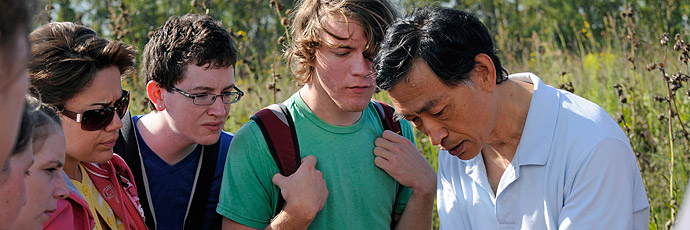
Russell R. Kirt Prairie. Photo: COD Newsroom/CC BY 2.0
The Russell R. Kirt Prairie is a restored tallgrass prairie and savanna within the College of DuPage Natural Areas. The 18-acre natural area is bounded by Lambert Road to the west and Prairie Drive to the east, and by College Road to the south and Tallgrass Road to the north.
Professor Russell R. Kirt began restoring prairie in 1974, two years after Ray Schulenberg of the Morton Arboretum introduced him to the prairie. He started the restoration project at the college in 1981 by seeking seed money from the Board Of Trustees. With the help of numerous volunteers, including students, he obtained native seeds and seedlings from local preserves and broadcast the seeds randomly or transplanted seedlings in arranged groups. Professor Kirt noticed birds eating the broadcast seeds, and thinking they must be eating large seeds like those of sunflowers, he tried to overwhelm these seed predators by scattering an over-abundance of sunflower seeds, especially those in the Silphium genus. Perhaps as a consequence, today the prairie still has an abundance of these sunflowers, especially Silphium laciniatum (Compass Plant). The tallgrass prairie also has a healthy mix of native grasses such as the Illinois state grass Andropogon gerardi (Big Bluestem) and Panicum virgatum (Switchgrass), which has been gaining commercial interest as a potential source for biofuel.

A biology class at the prairie. Photo: Peter Chen/CC BY-SA 4.0
The prairie is located less than 100 meters from the college’s Health and Science Center, making it the only sizable restored prairie in the U.S. that is within walking distance of a college classroom building, and it is often used for field study by biology, botany, and environmental science classes. Faculty from the college and other institutions have conducted prairie ecology research on many species including native flora, small mammals, ants, and insects such as Trichapion rostrum (Baptisia Seed Pod Weevil).
Seeds collected from the prairie are traded with other restoration projects in the region. A greenhouse near the Health and Science Center is used to grow plants from seed, and nursery beds outside the greenhouse showcase selected native plants. The college offers a Prairie Ecology class (Botany 1320) that focuses on the tallgrass prairie ecosystem, with extensive hands-on studies in the prairie. Close to the prairie is the Community Education Fuel Garden where students learn sustainable agriculture. Starting in 2017, two beehives have been installed to provide pollination and to serve as a learning lab.
For those interested in the ecology of the prairie, look for a Trail Guide booklet in a small donation box near the sign to the prairie trail. In addition to providing good background information on North American prairies and phenological charts, it discusses topics such as ethnobotanical uses of plants, plant-insect relationships, and rare and endangered species. For example, page 19 lists the federally endangered Dalea foliosa (Leafy Prairie Clover) and the Illinois endangered Nycticorax nycticorax (Black-crowned Night Heron) as two species to look for at the site. More detailed ecological notes and drawings can be found in Professor Kirt’s book Prairie Plants of the Midwest: Identification and Ecology (1995, Stipes Publishing ISBN 0875635733, previously published as Prairie Plants Of Northern Illinois: Identification And Ecology in 1989).
In 1995, Professor Kirt conducted an inventory that identified 293 native and introduced plant species in 31 floral families. Each species is associated with a Coefficient of Conservatism that enable ecologists to determine the Floristic Quality Assessment of an ecosystem. Unfortunately, the Coefficient of Conservatism data are not included in his book; please consult the Russell R. Kirt Prairie Plant Gallery where this valuable information is still preserved.
Many citizen scientists have used the prairie as a monitoring site for birds, frogs, butterflies, dragonflies, etc. The diversity of flora and fauna at the site is documented at the citizen science portals eBird as a hotspot and at iNaturalist as a place as well as a project.
Guided tours and work days are led by the prairie manager Remic Ensweiler; information about these events can be found at the COD Natural Areas page. You can also keep up on latest happenings in the prairie at the corresponding Facebook page.
Additional Resources on Russell R. Kirt Prairie
Russell R. Kirt Prairie – Wikipedia
Natural Areas – College of DuPage
COD Prairie Tour – Go on a virtual walkthrough of the Ecological Study Area and the Russell Kirt Prairie. Learn about the history of these areas, current problems/issues, and future ecological restoration plans.
Click here to see pictures taken from Greater DuPage Wild Ones Native Plant Walk at Russell R. Kirt Prairie in June of 2018.
